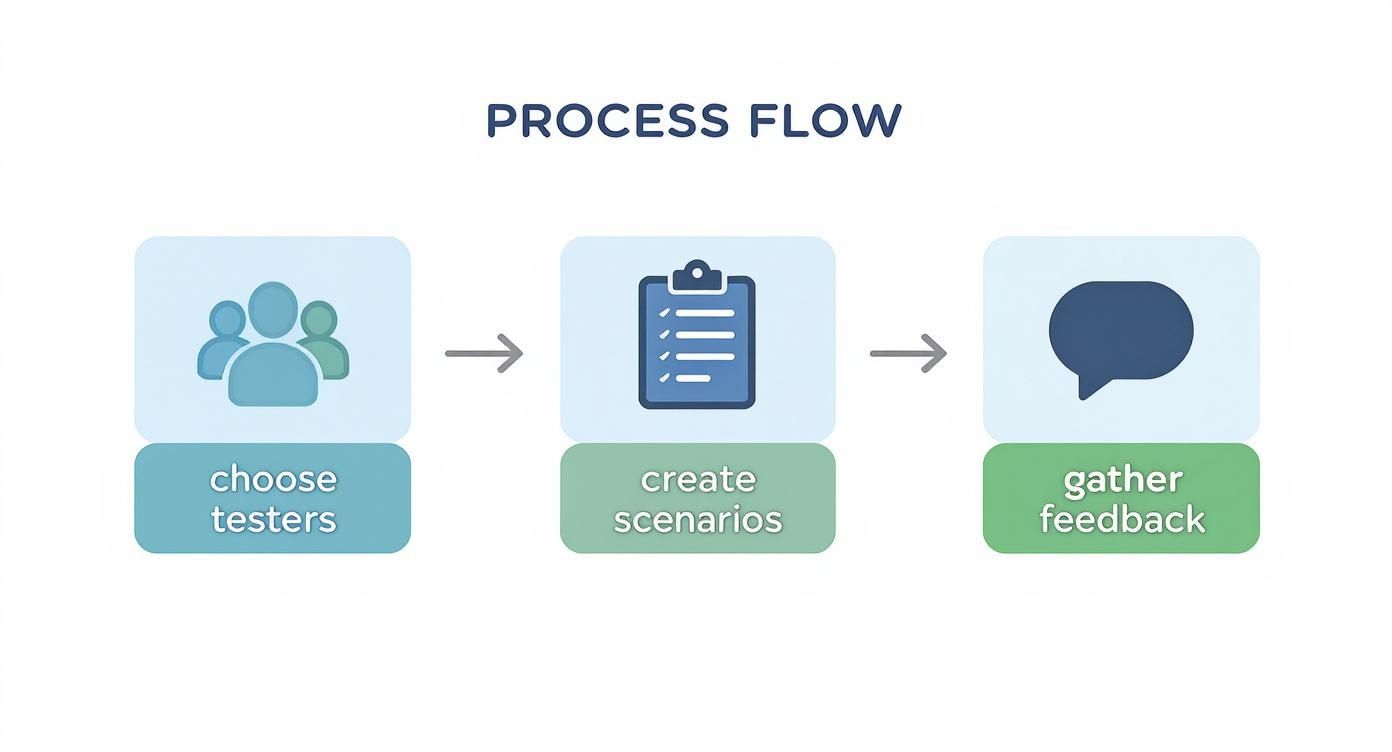If you're a seasoned founder, you know speed and quality are everything. Mastering the testing phases in software testing isn't a roadblock—it's your secret weapon for turning a good MVP into a fantastic one that's ready to scale.
Forget thinking of a structured testing process as a chore. It's a launchpad, guaranteeing you're building a rock-solid foundation that will drive growth and seriously impress investors. Think of it as de-risking your investment, one feature at a time.
Why a solid testing plan is your secret weapon
Let’s cut to the chase. You’ve been in the startup trenches before. You get that launching an MVP isn't just about shipping something—it's about shipping the right thing, a product that just works and has users hooked from day one.
Trying to save a few quid by skimping on proper testing is a classic rookie mistake. Sure, it feels faster at first, but it always comes back to bite you with expensive bug fixes, a hit to your reputation, and a rickety foundation that can't handle your big-picture plans for monetisation and growth.

A smart approach to testing isn’t about pumping the brakes; it's about building momentum without the risk of a crash. This discipline is becoming the standard. In the United Kingdom alone, the software testing services market is valued at around £1.3 billion, which tells you everything you need to know about its importance. You can dig into the UK's growing software testing market insights on ibisworld.com to see the trend for yourself.
The four pillars of awesome quality assurance
At its core, the whole process rests on four key phases that fit together perfectly. Each one examines your product from a different angle, making sure no gremlins slip through into production.
Unit Testing: This is testing at the microscopic level. Your developers inspect the smallest, individual pieces of code. Think of it like checking every single LEGO brick for defects before you even start building.
Integration Testing: Now it’s time to click those LEGO bricks together. This phase is all about making sure different modules, services, and components of your app can talk to each other without causing a meltdown.
System Testing: We’re zooming out to look at the entire LEGO castle. This is where we test the complete, fully assembled application to confirm it meets all the business requirements you defined.
Acceptance Testing: The final sign-off. This crucial last step confirms the product not only works technically but actually solves the user's problem and delivers the value you promised.
Getting how these phases link up is the first step to building a product that leaves everyone ‘appy. 🤓
Laying the foundation with unit and integration tests
Building a truly great product starts from the inside out, right down to the individual lines of code. The first two testing phases in software testing are all about making sure your foundation is absolutely solid before you start building skywards. Honestly, get this part right, and you'll save yourself a world of pain and cash later.

This early-stage focus isn't just a developer thing; it’s a massive strategic advantage for any founder. By catching issues at the source, you dramatically slash the cost and effort of fixing them later on. This keeps your MVP timeline on track, your burn rate down, and your first users happy.
Checking every brick with unit testing
Imagine you're building something complex with LEGOs. Unit Testing is like inspecting every single brick to make sure it's perfectly formed before you even think about clicking them together. It’s your first line of defence against bugs.
We're talking about testing the smallest, most isolated pieces of your code—an individual function, a single method—to confirm it behaves exactly as it should. This is squarely in the developers' court. They write small, automated tests right alongside the features they're building. The whole point is to prove that each tiny component does its one job perfectly.
Actionable advice: As a founder, the best thing you can do here is to champion a culture where unit testing isn't seen as a chore, but as a huge time-saver. When your developers are empowered to write good tests, they build with more confidence and speed, which directly fuels your team’s momentum.
Making sure the bricks click together
Okay, so your individual bricks are flawless. Brilliant. Now it’s time for Integration Testing. This is all about making sure those bricks actually connect and work together without falling apart.
Does your user login module correctly talk to the user profile service? When a customer clicks "buy", does the payment gateway successfully communicate with the order management system? These are the questions integration testing answers.
It’s all about checking the connections and the flow of data between different parts of your application. This is where you catch those frustrating issues like mismatched data formats, broken API calls, or one component simply not understanding another.
For a startup, this is non-negotiable. A stable MVP depends on its various parts cooperating perfectly. Pouring effort into these early testing phases ensures your product is built on a reliable, bug-resistant core, making it ready for whatever complex features you dream up next.
Seeing the big picture with system testing
Right, we've checked the individual code bricks (unit testing) and made sure they click together nicely (integration testing). Now it's time to zoom out and look at the entire LEGO castle. This is System Testing, the full-dress rehearsal before your product ever sees the light of day.
This phase is where your fully assembled product gets a proper shakedown. We're no longer looking at isolated parts; we’re testing the complete, integrated system to see if it delivers on its promises from end to end. Think of it as a complete user journey, from the moment they land on your site to the final checkout click. It’s about building total confidence before you go live.
Functional and non-functional checks
System testing isn't just one thing; it's a mix of different checks that look at your product from every possible angle. This is where you verify both what the system does and how well it does it.
Functional Testing: This is the straightforward stuff. Does the login button actually log a user in? Can someone add an item to their cart and successfully pay? We’re essentially ticking off a checklist to confirm the application behaves exactly as specified in your requirements. It either works or it doesn't.
Non-Functional Testing: This is where things get really interesting, especially for founders aiming for scale. We're testing performance, reliability, and usability. Can the platform handle 1,000 users all at once without grinding to a halt? How quickly do pages load? We explore these crucial aspects further in our guide to understanding non-functional requirements.
This level of scrutiny is essential everywhere, but especially in regulated industries. For instance, the UK's financial services sector, which makes up about 31% of the country's software testing market, relies heavily on system testing to meet strict security and reliability rules. You can explore more about the stringent testing processes in this sector by reading the full market insights from KPMG.
Your strategic role as a founder
Your input here is absolutely vital. You don’t need to be in the weeds writing the tests, but you absolutely need to help define what success looks like. This means working with your team to establish clear, measurable criteria for what "good" actually means.
Actionable advice: A key goal of system testing is to de-risk your launch. By setting clear Key Performance Indicators (KPIs)—like "user login must take less than 2 seconds" or "the system must support 500 concurrent users"—you turn vague goals into concrete targets that investors love to see.
This phase is your final internal quality gate. It’s the last big check before you put your product in front of the people who matter most—your users. Getting this right ensures the product they see is polished, reliable, and ready to make them feel ‘appy. 🤓
Getting the green light with user acceptance testing
This is it—the moment of truth. After all the internal prodding and poking, User Acceptance Testing (UAT) is the final hurdle before your masterpiece goes live. It’s where actual, real-life users get their hands on your app and give you the ultimate nod of approval. This isn't just another bug hunt; it’s about confirming you’ve actually built the right product that solves a genuine problem.
For any seasoned founder, UAT is your last and best chance to validate product-market fit before you start funnelling serious cash into marketing. It’s time to ditch the assumptions. This phase gives you hard evidence that your solution truly clicks with your target audience, making sure your launch starts with a bang, not a whimper.
More than just squashing bugs
While system testing confirms your app works from a technical standpoint, UAT answers a far more important question: does it work for the user? Does the flow feel intuitive? Can they actually get from A to B without wanting to throw their phone at the wall? This is where the focus shifts from "Can the feature work?" to "Will people actually want to use this feature?"
It's all about observing real human behaviour. You’ll uncover insights your internal team, with their deep-seated knowledge of how things are supposed to work, would simply never spot. This feedback isn't just gold; it's a direct line to creating a product people are genuinely ‘appy to use.
Actionable strategies for killer UAT
Running a successful UAT session isn’t about just chucking your app at a few people and hoping for the best. To get feedback that’s truly worth its weight in gold, you need a plan.
Here’s a simple, no-nonsense approach:
Find Your People: Don’t just grab your mum or your best mate (unless they’re your target user!). Your testers should be as close to your ideal customer profile as you can possibly get. Their perspective is the only one that truly matters for validating your business case.
Craft Real-World Scenarios: Ditch vague instructions like "test the checkout". Give them a realistic mission instead. Something like, "Imagine you need to buy a gift for a friend. Find a blue jumper, add it to your basket, and complete the purchase using a discount code."
Shut Up and Watch: Seriously. Your job is to observe and take notes, not to jump in and guide them. Pay close attention to where they hesitate, what trips them up, and what makes them smile. You’re after their unfiltered experience.
Actionable advice: The goal of UAT isn't to chase a mythical, bug-free product—that’s an impossible dream. The real objective is to gain the confidence that your product delivers genuine value and is ready for the market. It’s your final go/no-go decision point before spending big on customer acquisition.
By really leaning into UAT, you’re not just testing software; you’re stress-testing your entire business hypothesis. It’s the final, crucial step in the testing phases in software testing that ensures you’re launching a product with the best possible shot at success.
Embedding testing into your agile workflow
In the startup world, things move fast. The old-school waterfall model, where testing is a big, scary boss battle you face right at the end, is a recipe for disaster. It just doesn’t work when you’re living and breathing in agile sprints.
Your testing process has to be just as agile as your development. The secret? Stop thinking of testing as a separate stage and start weaving it into the very fabric of your development cycle. This changes everything. Suddenly, quality isn't a final hurdle to jump over; it becomes a shared responsibility for the entire team. It’s all about creating a constant feedback loop, building quality in from day one.
Making testing a sprint-level habit
To pull this off, you need a clear map of how the different testing phases in software testing fit into your agile workflow. Unit and integration tests become your daily companions—they should be an integral part of every single development task. When a developer finishes a new feature, they're not really 'done' until they've also written the tests to prove it works as expected and doesn't break anything else.
This isn't about piling on more work; it’s about working smarter. Catching an integration bug minutes after the code is written is infinitely cheaper and quicker to fix than discovering it weeks down the line. By making these tests a non-negotiable part of your "definition of done," you build an incredible safety net. This net gives your team the confidence to move faster, experiment more, and innovate without fear. You can see exactly how we structure these cycles in our guide to agile product development sprints.
Actionable advice: Think of it as your own ‘build-measure-learn’ cycle, but for code quality. Each sprint delivers more than just a new feature; it delivers a validated feature, battle-hardened by immediate, relentless testing. This accelerates your progress towards product-market fit.
Aligning system and UAT with your release cadence
So, while unit and integration tests are happening constantly, where do the bigger tests fit in? System Testing and User Acceptance Testing (UAT) align perfectly with your broader release cadence. As a major sprint wraps up or you're approaching a big release milestone, that's your cue to run comprehensive system-level checks. This is where you ensure the whole product hangs together as a cohesive, stable experience.
Then comes UAT. This is your final, crucial reality check before you hit the launch button. It’s the moment you confirm that the brilliant thing you’ve built actually solves a real user's problem in a way that feels intuitive and delightful.
Here’s a simple but incredibly effective way to visualise the UAT process.

This kind of structured approach means you're not just collecting random opinions. You're gathering actionable data that tells you whether you're truly ready for launch. By baking testing directly into your agile rhythm, you build a powerful engine for rapid, high-quality development, making sure every single release leaves your users feeling ‘appy. 🤓
Supercharging your testing with automation and AI
Let's be honest, manually re-testing every single feature after every tiny code change is a soul-destroying process that just doesn't scale. As a founder, you need your team's brainpower focused on building the next great thing, not on repetitive clicks. This is exactly where automation and AI can supercharge your testing phases in software testing.

This isn’t about replacing your fantastic team; it's about giving them superpowers. Think of test automation as a tireless assistant who handles all the monotonous but critical checks. This frees up your human testers to do what they do best: creative, exploratory testing that finds those really subtle and tricky bugs.
Getting started with test automation
So, where do you begin? The biggest bang for your buck almost always comes from automating your regression tests. These are the tests you run over and over again to ensure a new feature hasn't accidentally broken something that used to work perfectly.
Here’s where to focus your initial automation efforts:
- Core User Journeys: Automate the absolute must-work paths, like user registration, login, and the main checkout flow. If these break, you're in trouble.
- High-Traffic Features: Any part of your product that gets a ton of user traffic is a prime candidate. You need rock-solid stability where it matters most.
- Data-Driven Tests: Think of scenarios that need testing with lots of different data inputs. An automated script can plough through hundreds of variations in minutes, a task that would take a human tester days.
The rise of AI in testing
Now, let's talk about the next level. Beyond simple scripted automation, AI is bringing a whole new layer of intelligence to quality assurance. We're moving past just running pre-written scripts and into the realm of predicting problems before they even happen. For instance, some AI tools can analyse your code and flag areas most likely to contain bugs, helping your team focus their manual testing efforts far more effectively.
Actionable advice: The shift towards smarter testing is already happening. Today, up to 73% of UK organisations are aiming for a healthy balance of manual and automated testing, blending human intuition with machine efficiency.
AI is becoming a true game-changer. The market is projected to grow at a compound annual rate of 37.3% through 2030, driving huge improvements in areas like defect prediction and test reliability. If you're curious, you can find more software testing statistics and trends that paint a clear picture of where the industry is heading.
By starting small and strategically applying automation and AI, you create a massive advantage. You’ll be able to ship better products, faster. It’s how you build a product that keeps everyone ‘appy. 🤓
Common questions about software testing phases
Got questions? We've got answers. Here are a few common queries we hear from founders trying to get their heads around the different testing phases in software testing.
How much of my budget should go to MVP testing?
There isn't a single magic number, but a smart rule of thumb is to set aside 15-25% of your total software development budget for quality assurance. Think of it this way: for an early-stage MVP, this isn't just a cost. It’s a vital investment to stop expensive headaches down the line, like users abandoning your app or a critical bug wiping out your launch momentum.
Can my developers handle all the testing?
It’s a tempting thought, but it’s a classic pitfall. While your developers are absolutely the right people for unit and integration testing, asking them to handle everything creates massive blind spots.
Developers naturally test the 'happy path' – the way they expect the software to work. A dedicated tester or QA expert brings a fresh pair of eyes, deliberately looking for the unexpected issues that can trip you up. If you have more questions like this, you'll find plenty more answers in our frequently asked questions section.
When should we start automating tests?
Sooner than you probably think, but you have to be clever about it. Don't fall into the trap of trying to automate everything from day one.
The best place to start is with the stable, most critical parts of your app that get tested repeatedly. Think user login flows or the core checkout process. Start small, prove the value, and then expand your automation efforts as your product grows and matures.
Ready to build a rock-solid product that users absolutely love? At AppyCamper Ltd, we weave expert testing into every single sprint. We make sure your MVP doesn't just launch, but launches flawlessly and is ready to scale from the get-go. Let’s build something incredible together at https://appycamper.com.


